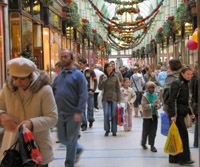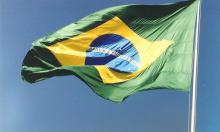Russians spend thrice as much on New Year shopping as they usually do
Sale signs are designed to send a clear signal to the consumers: come and buy it at specially reduced prices for a limited period of time. The New Year holiday season is just around the corner. It stands to reason that the consumers would like to take advantage of buying presents for their loved ones and friends at a discount.

Experts estimate that Russians spend at least 30-40% more on December shopping than they do in other months of the year. The consumers spend more at the end of the year because of the season’s sales that tempt them to go on a shopping spree big time. Besides, Russian retailers use all kinds of tricks to get the customer spending.
Is the Russian sale really worthwhile? Is it a thrifty way of spending or a waste of money in disguise? Komsomolskaya Pravda asked the experts to comment on the subject.
Goodies are up for grabs
The fists sales on the Russian consumer market were launched by major Western department stores some 10 years ago. A sale of consumer goods at reduced prices gained quick popularity with the Russian consumers. End-of-season sales are something of the bon ton for the stores these days. The number of stores selling merchandise at a discount has been steadily growing in Moscow. Even the street peddlers imitate this highly popular consumer market trend by posting cardboard signs on their stalls to announce that “every item on display costs 50 rubles.”
An increasingly large number of Russians are trying to shop for clothes during the sale seasons only. December is the main sale month of the year. Many stores sell the whole stock at half a price. Small wonder their receipts go up by 2-3 times as people sweep the shelves clean in a shopping spree late December.
On the one hand, you can save up a couple of rubles when buying goods at reduced prices on a sale. However, some consumers seem to be affected by a dangerous psychological factor built around the prices slashed by 50%. They often end up spending their money saved on cut-price deals and cannot help buying more and more because merchandise at unusually low prices look simply irresistible to them.
Fake discount
These days you had better use your head every time you are in the mood for shopping, otherwise you will waste lots of money and buy the wrong goods. Oksana, a friend of mine, calls herself a smart shopper. She says she knows a lot about the pros and cons of a season’s sales. She shares with me a few tips on the art of discount shopping as we look around a huge department store in the center of the city.
“You should keep an eye on the thread you’re after from the moment you spot it in a store,” says Oksana. “You check the store out at the start of the season and make your choice. And don’t you panic when you see the price tag. You simply wait for two months and buy the thing 50-70% cheaper when they cut the price by season’s end. Now look, this blouse was initially priced at $450. Today I’m going to buy it for $200. That’s the way it goes, shopping is good when the time is ripe,” Oksana adds.
Retailers try to exploit the growing appetite of the Russian consumer for discount shopping. Back in Soviet times, when most consumer goods, especially the foreign-made ones, were in short supply the consumer at times had to travel to the moon and back to get a hold on a pair of blue jeans or household item. Needless to say, the goods that took a lot of effort to obtain would be the most enjoyable goods of all. The infamous era of consumer goods shortages came to en end shortly after the Soviet Union ceased to exist. Nowadays the Russian consumer derives special pleasure from buying low-priced threads on a sale.
“Hurry up ‘cause we’re running out of stock” says a sign posted on the display window. The announcement is part of a marketing camping to stir up consumer interest.
“A well-informed shopper can always tell whether the clothes belong to the new trend or not,” says Oksana. “They often sell out things that were left unsold in a store twoyearsago.Theytryto disguise the old stuff as a new collection. If you hate being bamboozled out of your money, you’d better drop by the stores regularly and browse some fashion magazines too,” adds she.
Why are the clothes in Russia so expensive?
It is true that the number of stores selling at a discount keeps growing in Moscow and other major cities across Russia. It is also true that the situation has nothing to do with retailers’ charity. Retailers can make nice profits even by selling goods at reduced prices. So you can appreciate the markup added to the basis price.
“It’s an open secret that clothes will cost you less if you buy them abroad,” says Olga Komissarova, a director of Solution Tree. “Bearing in mind that some of the Russian stores buy their merchandise abroad by wholesale at lower prices, the markup is pretty high. That’s why many Russians opt to go shopping for clothes while abroad. It’s a better deal in terms of quality and price,” says Komissarova.
Any way you look at it, shopping abroad is much cheaper. The amount of goods purchased for 1,000 euros in Europe would be simply beyond comparison to that purchased for the same sum in Moscow. So why are the Russian stores so notoriously expensive?
“Such factors as wholesale price, transport costs, taxes and rent contribute to the formation of a final price,” says Svetlana Titova, editor-in-chief of the web site Rasprodaga.ru. Moscow has one the highest rent rates in the world. On the other hand, the rent in New York is even higher yet the retail price of consumer goods is much lower over there. An article of clothes by Guess will cost you an average of 5,000 rubles ($200) in a Guess store located in Moscow’s Okhotny Ryad shopping mall. For comparison purposes: a jeans skirt of the same brand is available at $35 in a Guess store located in Sawgrass Mall, New York. Guess corduroy jacket costs $98 in the same store. Clothes that cost 100 euros in Moscow can be bought for 20 euros in Italy. In terms of clothes manufactured by well-known companies, the price difference is even more notable. But people buy the overpriced threads like crazy anyway. Just take a look at the long lines during the sale season,” Titova says.
According to experts from Deloitte & Touché, Russians spend a lot more money during New Year’s shopping frenzy. Russians are estimated to spend around 13% of their annual income on end-of-year shopping, while the Irish spend less than 4% for the same purposes.
“Judging by the figures, we seem to enjoy a better life than those moneybags in the West. Do the figures have anything to do with the actual well-being?”
“These estimates point out the different bills the Russians and Westerners have to pay, so to speak,” says Elena Matrosova, director of the Center of Macroeconomic Studies under BDO Unikon company. “No matter how paradoxical it may seem to you, the Russian consumer is more inclined to spend a bigger part of his income on clothes, compared to the European costumer. The Russian gets his paycheck and uses part of it for paying utilities, food and other basics. And he’s ready and willing to spend the remaining part on clothes and stuff because he believes that saving his money up is completely useless,” says Matrosova. People don’t know what the future holds. They’d rather spend their money on clothes today than save it up for purchasing an apartment in the future. People see an apartment as pie in the sky so this sort of attitude is hardly surprising,” Matrosova adds.
On the contrary, both Europeans and Americans use a larger part of their income for paying back loans. They normally buy their cars and houses on credit. The remainder of their income is spent on food, education and vacation. Retailers are well-aware of the fact that the consumer in the West does not have money to burn when it comes to clothes. Therefore, they sell their goods at reasonable prices. Otherwise, no one is going to buy merchandise.
Komsomolskaya Pravda
Translated by Guerman Grachev
Pravda.ru
Subscribe to Pravda.Ru Telegram channel, Facebook, RSS!




